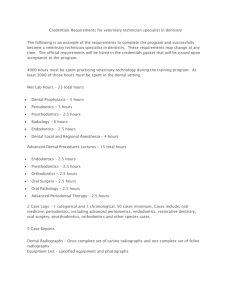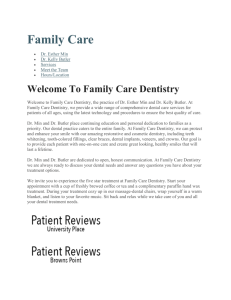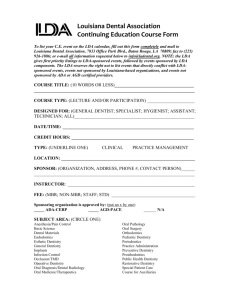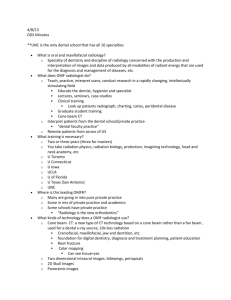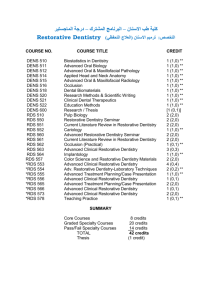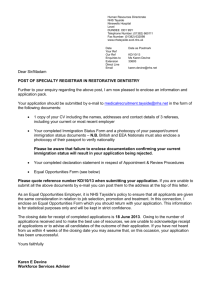Cardiff 2007 - International College of Dentists
advertisement
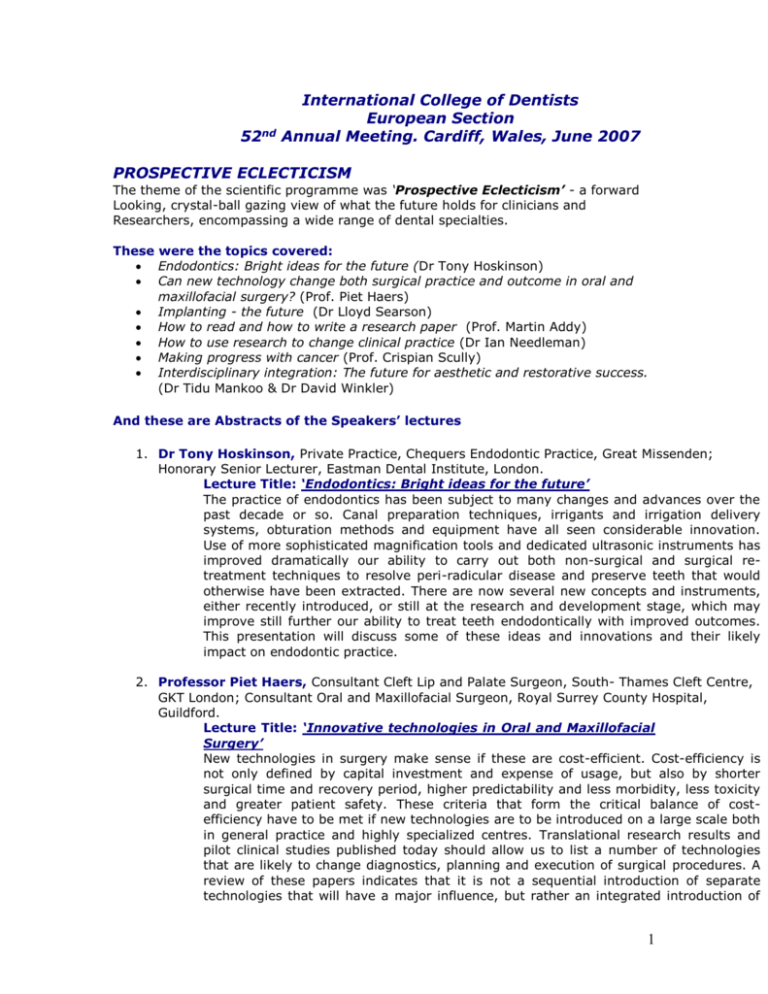
52nd International College of Dentists European Section Annual Meeting. Cardiff, Wales, June 2007 PROSPECTIVE ECLECTICISM The theme of the scientific programme was ‘Prospective Eclecticism’ - a forward Looking, crystal-ball gazing view of what the future holds for clinicians and Researchers, encompassing a wide range of dental specialties. These were the topics covered: Endodontics: Bright ideas for the future (Dr Tony Hoskinson) Can new technology change both surgical practice and outcome in oral and maxillofacial surgery? (Prof. Piet Haers) Implanting - the future (Dr Lloyd Searson) How to read and how to write a research paper (Prof. Martin Addy) How to use research to change clinical practice (Dr Ian Needleman) Making progress with cancer (Prof. Crispian Scully) Interdisciplinary integration: The future for aesthetic and restorative success. (Dr Tidu Mankoo & Dr David Winkler) And these are Abstracts of the Speakers’ lectures 1. Dr Tony Hoskinson, Private Practice, Chequers Endodontic Practice, Great Missenden; Honorary Senior Lecturer, Eastman Dental Institute, London. Lecture Title: ‘Endodontics: Bright ideas for the future’ The practice of endodontics has been subject to many changes and advances over the past decade or so. Canal preparation techniques, irrigants and irrigation delivery systems, obturation methods and equipment have all seen considerable innovation. Use of more sophisticated magnification tools and dedicated ultrasonic instruments has improved dramatically our ability to carry out both non-surgical and surgical retreatment techniques to resolve peri-radicular disease and preserve teeth that would otherwise have been extracted. There are now several new concepts and instruments, either recently introduced, or still at the research and development stage, which may improve still further our ability to treat teeth endodontically with improved outcomes. This presentation will discuss some of these ideas and innovations and their likely impact on endodontic practice. 2. Professor Piet Haers, Consultant Cleft Lip and Palate Surgeon, South- Thames Cleft Centre, GKT London; Consultant Oral and Maxillofacial Surgeon, Royal Surrey County Hospital, Guildford. Lecture Title: ‘Innovative technologies in Oral and Maxillofacial Surgery’ New technologies in surgery make sense if these are cost-efficient. Cost-efficiency is not only defined by capital investment and expense of usage, but also by shorter surgical time and recovery period, higher predictability and less morbidity, less toxicity and greater patient safety. These criteria that form the critical balance of costefficiency have to be met if new technologies are to be introduced on a large scale both in general practice and highly specialized centres. Translational research results and pilot clinical studies published today should allow us to list a number of technologies that are likely to change diagnostics, planning and execution of surgical procedures. A review of these papers indicates that it is not a sequential introduction of separate technologies that will have a major influence, but rather an integrated introduction of 1 innovations from different fields such as imaging, surgical simulation, computer assisted surgery, minimally invasive techniques, polymer science, metallic alloys, cutting devices, tissue enhancement technology, cellular biology and genetics. This involves not only multidisciplinary research but also an integrated industrial approach that may be more difficult to realize in order to assure cost-efficiency for the users – surgeons and patients alike. This challenge applies to all forms of surgery and will be illustrated with some examples in oral and maxillofacial surgery. 3. Dr Lloyd Searson, Consultant in Restorative Dentistry, Eastman Dental Hospital; Specialist Private Practice, London Lecture Title: ‘Implants – the Future’ Even with the elimination of dental disease there will always be a need for the use of dental implants to replace missing teeth. Since the early 1980s new surgical and restorative protocols have evolved and manufacturers have continued to produce new product lines increasing the range of componentry. The present position is that there are too many choices both in the surgical and the restorative areas of implant dentistry which has led to confusion among the dental professionals. In the future there will be a need to rationalise componentry and procedures to ensure that implant dentistry can become simply routine. The high demands set by clinicians will mean that dental implants of the future need to integrate quicker; function immediately and produce excellent aesthetics. Reflecting on the evolution of implant dentistry over the last two decades we now look towards the future and attempt to predict what may be expected. 4. Professor Martin Addy, Professor of Periodontology, Department of Oral & Dental Science, University of Bristol Lecture Title: A Reader’s and Writer’s Guide to the Publication of (Clinical) Research As suggested by the title, the topic has two distinct but related parts. The reader’s guide will concentrate on the importance of refereed publications as the source of scientific data. The required content of the fundamental parts of scientific papers will be described and discussed separately. Thus, the pertinent questions the reader should ask of the Introduction, Method and Materials, Results, Discussion, Conclusions and Abstract will be posed. In particular, the questions will contain the words "Adequate" and "Appropriate". Also, for recent clinical studies, the reader must ask whether the investigation conforms to the criteria of Good Clinical Practice. For the writer, consideration will include: freedom to publish, publication strategy, choice of journal and the peer review process. The differences between a thesis and a paper will be briefly discussed. As for the reading a paper, the fundamental criteria for writing the individual sections of a paper will be considered. The recent adoption by journals of statements relating to "Consort Guidelines" and "Conflict of Interest" will be briefly explained. 5. Dr Ian Needleman, Senior Lecturer and Honorary Consultant in Periodontology; Director, International Centre for Evidence-Based Oral Health (ICEBOH) Unit of Periodontology, UCL Eastman Dental Institute. Lecture Title: How to use research to change clinical practice Progress in biomedicine and dentistry is moving rapidly. However, one of the biggest challenges to improving health and wellbeing remains the question of how to get important research developments into clinical practice. Indeed, coping with the information explosion in the digital era can seem more of a problem than an opportunity. In this presentation, I will examine why the effective use of research is so critical to patient care with a number of striking examples of what happens when things go wrong. I will also look at solutions so that as clinicians, we may be more confident in our use of research developments. 2 6. Professor Crispian Scully CBE, Dean and Director of Studies and Research, Eastman Dental Institute Lecture Title: Making Progress with Cancer Oral cancer is the most important condition seen by the dental profession. It appears to be increasing in incidence, and also affecting younger people, while the mortality has hardly improved over the past 25 years. Though largely seen in the developing world, some of the areas of highest recorded incidence are in Europe, and the regional and national variations raise questions as to aetiology. Better understanding of the aetiopathogenesis should lead to more accurate and earlier diagnosis and more effective treatments with fewer adverse effects. Cancer is the result of DNA mutations arising spontaneously and from the action of various mutagens, especially in tobacco, alcohol, betel and some micro-organisms. A sequence of genetic changes leads eventually to loss of growth control and autonomy. Countering these changes are mechanisms to metabolise carcinogens, repair DNA damage, control growth, and defend against cancer. Cancer is a consequence of an interaction of these many factors. Diagnosis is increasingly aided by detection of cellular and now molecular changes. Treatment is increasingly looking towards chemotherapy and now gene therapy. However, there is no doubt that prevention is the most important aspect, particularly patient education and the reduction of risk habits and environmental factors –focused at the groups at greatest risk. 7. Dr Tidu Mankoo and Dr David Winkler, Private & Referral Practice, Windsor Centre for Advanced Dentistry, Windsor Lecture Title: Interdisciplinary integration: The future for aesthetic and restorative success The rapidly changing face of Restorative Dentistry today presents us with new developments and techniques providing an ever expanding armamentarium to help us meet the challenges presented to us by our patients. An inter-disciplinary approach, sound knowledge and awareness of new technology and materials, as well as a foundation in the fundamental principles of Restorative Dentistry, are essential if we are to strive not only for optimal function, but also biologic and aesthetic harmony with long-term predictability. With this inter-disciplinary approach we are able to restore ever more complex cases predictably and restore not only function, but also produce restorations that mimic the natural dentition biologically and aesthetically. The increased importance of aesthetics in dentistry necessitates an interdisciplinary team approach and a structured protocol for diagnosis, treatment planning and case management. 3



